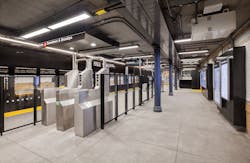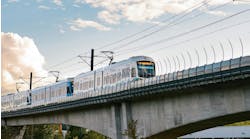Design-build team completes modernization of three MTA subway stations
The Metropolitan Transportation Authority (MTA) and the design-build team of Urbahn Architects, Citnalta-Forte and HAKS announced renovations have been completed at one subway station in Manhattan and two subway stations in the Bronx.
The combined $88 million modernization involved structural, infrastructure, safety and passenger comfort enhancements to the Number 3 train/IRT Lenox Avenue Line’s 145th Street station in Manhattan, and the Bronx’s B and D trains/IND–Concourse Line’s 167th Street station and the B and D trains/IND–Concourse Line’s 174th-175th Street station. New York City-based architect and planner Urbahn served as the lead architect for the first two stations, while engineering firm HAKS was the lead architect for the third station. The design team worked with the design-build contractor, Citnalta-Forte.
The work improved the street presence of the stations’ entrances, modernized the information systems throughout, updated the look of the interiors, and upgraded the lighting and mechanical, electrical and plumbing (MEP) infrastructure to give the stations a clean look. Much of the work focused on the stations’ control areas and platforms, with the team making significant repairs to walls. The team also renovated items that had deteriorated structurally, repairing various structural steel and concrete elements. They also performed waterproofing and made extensive safety improvements. In addition, the team installed artists’ glass-and-ceramic mosaics within the platform walls of each station.
New York City Transit (NYCT) President Andy Byford said, “Structural fixes, as well as modern touches like more real-time service info, energy-efficient lighting and updated security systems, mean safer, easier to use stations for our customers.”
The Manhattan station was completed in about four months, while the Bronx stations took about 18 weeks each.
“To get the work done quickly, we issued design submissions on an accelerated schedule, made heavy use of work trains to move materials in and out of the stations, and had the workers on extraordinary schedules,” said Urbahn Principal Natale Barranco. “All of this, coupled with the design-build procurement method, allowed MTA to reopen the stations in only a couple of months, despite each station having been in continuous use for about 100 years prior.”
The Manhattan station had been in continuous use since it opened in 1904, while the two Bronx stations had been in operation since they opened in 1933. Little more than routine maintenance had been performed over the years, so critical repairs were necessary due to water infiltration, aging concrete ceilings and walls, and deteriorating structural steel, as well as daily wear-and-tear.
Additional team members included CSA Group, Inc., as the mechanical and plumbing engineer; GG Engineering as electrical designer; Domingo Gonzalez Associates as the lighting consultant; and Billings Jackson Design as industrial designer of digital information systems, managed by Urbahn. HAKS also served as communications engineer and structural engineer.
Overall Scope of Work
In addition to structural upgrades, turnstile areas were upgraded and all three stations were equipped with supplementary security cameras, enhanced LED lighting and an increased number of Help Points, which allow customers to communicate quickly with staff for assistance. The light fixtures are not only energy efficient, but the LEDs do not need to be replaced as often. Signage and lighting were both upgraded as well. In all three of the stations, the team reconfigured the fare-control areas using glass barriers, removing unsightly metal bars. As a result, sightlines have been improved.
Customer information screens that provide passengers with status updates and train arrival times were placed at the street entrances and mezzanines as well as on the platforms. People have information they need prior to paying and entering the turnstiles. Meanwhile, full-height digital screens were installed at the platforms, mezzanines and control areas. These provide map and route information as well as public service announcements.
Modernizations included electronic charging stations with USB ports and improved station signage. The team installed new station furniture and platform safety enhancements such as tactile edge warning strips.
All staircases were replaced. New treads, stainless steel handrails with support bars and guardrails with wire mesh were added. In addition, exterior handrails were equipped with LED linear lights embedded underneath.
“All three stations are now much more intuitive for riders, and they’re brighter and safer, as well,” said Urbahn’s Associate Principal, Ranabir Sengupta, who acted as visual quality manager on the projects.
145th Street Station
This Harlem station is on the National Register of Historic Places. Therefore, the team had the additional challenge of working with MTA’s historic preservation group and New York's State Historic Preservation Office (SHPO) to get approval for the work.
“We used an older glass tile to match what was used in the station’s original construction,” said Larry Gutterman, Urbahn’s design manager for the project. “Getting that sourced, replicated and delivered on time was a logistical challenge. We had similar issues to overcome with the selective mosaic repair we had to do, as well as the restoration of the terracotta cartouches that marked the station number.”
Reconstructing the street stairs at this location was more involved than at the other locations because the stairs at this station had been equipped with flood-mitigation devices. The team had to perform a selective removal of the sidewalk and, during the installation, integrate waterproofing around the entrances.
Custom-designed information display fixtures, totems, were installed at the street level to provide real-time service information before riders enter the station. The team also installed customer information systems on platforms. Each totem features a digital screen with changing subway and neighborhood information, and a green acrylic dome at the top indicating the entrance’s 24/7 operation. Solari Corporation manufactured the customer information systems installed on platforms. They feature LED screens with upcoming train information, status announcements and neighborhood maps.
New glass and ceramic mosaic artwork by artist Derek Fordjour appears throughout the 145th Street station. It pays homage to Harlem’s African American parade tradition and its pageantry. Miotto Mosaic Art Studios translated Fordjour’s layered surfaces, based on his richly textured paintings into mosaics.
167th Street Station
The station’s two side platforms were overhauled and upgraded. One of the challenges involved coordinating all of the signage and the lighting, but the team created an enhanced station that includes fixes to the electrical and communications systems.
Another challenge involved integrating the new artwork into the space. The artist, Brooklyn-based Rico Gatson, created “Beacons,” a series of mosaics that depict prominent figures from history and culture who have been influential in the Bronx and beyond.
174th-175th Street Station
At the south end of the station, riders must exit out to the street from underneath the station, via a lower mezzanine below the platforms. “
We introduced a canopy here to create a more welcoming entrance at the lower level,” said Urbahn’s Project Architect Ijeoma D. Iheanacho. She explained that this canopy is used to “announce” the station entrance as well as provide improved, more visible service information. Urbahn worked with Grimshaw to develop the final design of the canopy. It is made with two structural-steel columns that support a roof frame with a cantilevered glass panel over the entrance and clad in black-metal panels for drama.
Another challenge with this station was assessing and then selectively replacing the platform walls. They had been subjected to structural deterioration and water infiltration, so repairs were extensive. Once this was remedied, the team found they had a more replacement tile work than anticipated.
“Much of the original tile and glazed bricks had to be replaced. Marrying the new tile with the existing tile – getting it to match and complement each other – took some painstaking work,” said Urbahn’s Ryan Bieber, assistant visual quality manager on the project.
Similarly, the team had some selective replacement of the floors on the mezzanines, which meant they needed to tint the new concrete to match the existing color.
In addition, the team installed artist Roy Secord’s mosaics in this station called “Bronx Seasons Everchanging.”


